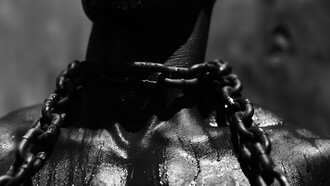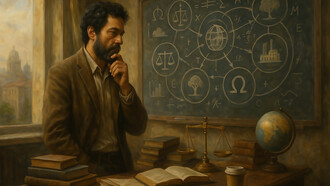Folded in like a dark thought
For which the language is lost,
Tuscan cypresses,
Is there a great secret?
Are our words no good?The undeliverable secret,
Dead with a dead race and a dead speech, and yet
Darkly monumental in you,
Etruscan cypresses.(D. H. Lawrence, extract from ‘Cypresses’, 1920-23)
In April 1927, three years before his death in 1930, D. H. Lawrence visited the Etruscan burial tombs of Cerveteri; Tarquinia; Vulci and Volterra - his interest in these sites was ignited by a former visit to Tuscany in 1920, where he wrote the poem Cypresses. Etruscan Places, Lawrence’s final travel book, ensued from his 6-day tour of modern Tuscany, and was comprised of six essays posthumously published in 1932. The Etruscans were an ancient population who inhabited central-western Italy, between Tuscany and Lazio, flourishing from approximately 800 to 250 BC. It was a people whose history survives only in myth, damaged frescos and indecipherable engravings etched into stone. Natural lifeforms, particularly evergreens and wildflowers, cling onto a vanished Etruria. Lawrence points to these strong, fierce, imperishable cypresses, which bear the weight of centuries of memory and primeval wisdom, binding the people of today to an Etruscan anima, still very much alight. Their origins are unknown; it is believed they were colonists from Lydia in Asia Minor who travelled by ship, although some historians, such as Dionysius of Halicarnassus, claimed they were natives of Italy, connected with the (Proto)Villanovan culture. The Etruscans founded an advanced culture: they dug canals, formed trade networks and produced iron tools, embellished bronze mirrors and numerical systems, and were highly influential to Roman development. The Necropolises of the towns of Cerveteri and Tarquinia constitute a rare testimony of this remarkable, immemorial civilisation. One of the largest sites in Cerveteri, for instance, is comprised of almost one thousand round burial mounds, termed tumuli.
Lawrence deeply respected the vivacious Etruscans. In them he saw the “last glimpses of a human cosmic consciousness”1 … the keepers of a lost secret. He could sense a wholeness and naturalness lingering deep within their tombs; a strong feeling of homeliness and happiness stained the air, enabling him to rest in a state of complete consciousness of being, freeing him from calendars and conventions, from self-sacrifice and redemption, all brought on by living amongst an ‘asleep’ rational English society. He was searching for a time behind the institutionalised Graeco-Roman-Christian civilisation2. Etruscan Places largely consists of Lawrence’s subjective interpretations, revealing his desire to illuminate the value of understandings gained from intimate personal experiences situated in place. By rejecting the corporeal world as a site of doctrine and representation, he channelled his focus on the rhythms, infectious atmospheres and day-to-day encounters that he saw in the tombs. The Etruscan body, to Lawrence, was a lively medium affected by natural forces and true, honest human interactions. This was a body that was free to roam under the sun, one that danced amongst olive trees, flushed by the sea-light. Underground, stood amongst frescos of diving fish and a spread-out sky, he noticed a real liveliness in these images: within these frescos, the clamour of leaves and the hot-blooded bird flowing through matter seemed more authentic and awake than that above-ground April day. It was here, in these small tombs, that Lawrence understood both the Etruscan’s mystical affection for nature and the hollowness of the human word of uttering it. Captivated by their untamed, buoyant movements, it was clear to him that any attempt to express their energy through language and fact would render them static, frozen and lifeless: the opposite of their true nature. As Fernihough3 signifies, “the people of Etruria were somehow able to respond to ‘Being’ spontaneously and openly”. The Etruscan paid tribute to the essence of the thing itself over the idea of the thing, and in this sense, their outlook greatly differed from Platonic idealism. A sense of touch over “the abstracted reality”4 was important. Lawrence scorned the institutionalisation of Etruscan artefacts - systemised in solid cabinets of faraway museums, along with the routine decoding and dissection of images into fixed representations and condensed scientific journals. This only separated these ancient people from their local roots. Experience is what mattered most to Lawrence. We must get up close to the ruins, these fragments of history, to notice the finer details and original context, where one can appreciate them in terms of an intricate system of assemblages. "Travel", Durrell5 states, must be "a science of intuition," rather than a research project.
The first burial ground Lawrence entered was the ‘Tomb of Hunting and Fishing’. The tomb is made up of two chambers: in the outer room, there are depictions of hunters, whilst the inner room contains a scene of fishermen sailing in a wooden boat, and to the right a man from a sling-shot fires at a flock of vibrant birds. He follows steps that drop down to a single, bare tomb. His route is lit up by a single acetylene lamp, held by his tour guide. There is no seeking to transcend upwards into another metaphysical realm, nor is there any desire to cave into the blackness of the underworld, to escape and push away from life. Instead, in these rock-cut chambers, Lawrence absorbed the anima of the Etruscans, which to him represented the entire cosmos. He was struck by the vitality of the human through the warm-faced Etruscan who embodied a sudden, timeless stillness. Lawrence shared with the unknown artist a vision of the physical world as an immense continuum. He felt such a kinship with natural elements- wind, sun and sea, that he responded instantly to the “spontaneity in the shapes and movements of the underworld walls and spaces.”6The flame-lit tomb breached through the boundaries of his skin, enveloping him into a fluid, seamless reality, consisting of pointed fingers overlapping with shooting tree branches and growing green buds extending outwards, and with flocks of birds flying overhead. Their limbs were “full of life to the tips”7 and underworld birds are visible “with the draught of life still in their wings.”8
After surfacing back up towards great grassy mounds, he descends underground again, into the Tomb of the Leopards (Tomba dei Leopardi), named after two rivalling, open-mouthed leopards painted over a banquet scene. The tomb, dating to around 480–450 BC, is situated within the Monterozzi necropolis and contains one of the best-conserved murals of Tarquinia. Curving limbs, clothed in a drooping cloak; feasters, dancers, musicians and mourners – nothing could be more potent with life. For D. H. Lawrence, these ancient people became great because “they have gathered into themselves core after core of vital potency from the universe, till they are clothed in scarlet, they are bodily a piece of the deepest fire.”9 Vitality is the unifying theme of Lawrence’s Etrurian world, vitality as typified in the absorption of cosmic energy, but we must be careful not to overlook this world as one without sacrifice. In Lawrence, vitality was fiercely imbued with an affirmative type of death and contingency, whereby in order to reach death, you must dive into the vast sea and depart to another world, into the blue burning of the one fire. It is true that images of blossoming natural forms abound in Lawrence’s Etruscans, but at times, in their coming-and-going, they threaten to smother the last cosmic fire (as in the case of the wings of the water-deities that evaporate into the sun, or the curving tail of the dolphin which threatens, in torrents, a downpour of death). Beneath the lightness of these everyday scenes hides a dusky burning blaze.
The soul of the universe is held together by a harmonic force, which rushes together and then rushes apart. He alludes to scenes in which juxtaposition is the distinguishing characteristic, whereby Earth and waters lay side by side. And since all things were in contact and synchronisation, the human freely mirrored itself within the natural environment. At once there is an inexhaustible myriad and wholeness: “the cosmos was one, and its anima was one; but it was made up of creatures. And the greatest creature was earth, with its soul of inner fire. But in juxtaposition to earth lay the sea, the waters that moved and pondered and held a deep soul of their own.”10Here, space, time and consciousness become blurred in a single plane of existence. With this realisation, a kind of osmosis takes place, an inter-mingling self and world; a strong interconnectedness between modern Tuscany and ancient Etruria starts to appear. Lawrence draws attention to the ontological unity of the Etruscans. One such example is their practice of a form of ‘haruspicy’ - the art of fortune-telling through reading animal entrails, driven by a belief that nature was imbued with prophecies and signs from the gods. The Liver of Piacenza, a model of a sheep liver cast in bronze, discovered in 1877, illustrates their fascinating conception of the Earth, sun, moon and the 16 heavenly bodies. Each of the illustrated zones corresponds to its appropriate god. It was likely utilised as a celestial map as a way to assimilate key occurrences that would take place in each of the zones. Trained priests, named Augurs, were taught to read the signs and the portents, to search for an indication of how to best run the course of some important matter.
With every passing year, the walls have weathered, frescos have faded, layers have crumbled away, time has scratched away at the wholeness of the image. Yet, an inner reality survives under the presence of erosion. Symbols were destroyed, though not the forces they embody. These deathless Etruscans, whose blood streams from century to century. With their wooden houses, they had managed to attain this level of modesty and transience: “so that the Etruscan cities vanished as completely as flowers,”11but even still, all is not lost completely: the jovial-faced quality of the life-loving Etruscan survives in certain modern-day Italians that Lawrence encountered on his trip. We see in the Etruscan a natural, entire acceptance of life as opposed to an endless victory of force, characteristic of the Romans, who, with their belief in the supreme law of conquest, swallowed up Etruscan culture around the third and the second centuries BCE. For 130 years, the Romans invaded Etruscan city-states before finally overtaking the last, Velzna, in 265 B.C. With their fixed concrete structures, such as straight roads and piercing impenetrable columns, the spirit of Roman civilisation differed in every way from the Etruscans, who existed with ease and flow, celebrating the humour of life. Immersed within their tombs, a strange yet powerful pulse ran through Lawrence, and with this experience, he was recreated, re-emerging with a new vision of a unified, harmonious, sensual world which stirred and danced. Lawrence sought to pull us back towards the Etruscan anima, to resurface their meaning, which the Roman rulers trampled on, but that is still bound inviolable in tall cypress-trees, Etruscan cypresses.
References
1 Lawrence, D. H. (1992) Etruscan Places. Cambridge University Press, p.176.
2 Kinkead-Weekes, M. (1996) D H Lawrence: Triumph to Exile 1912-1922. Cambridge University Press, p.315.
3 Fernihough, A. (1993) D. H. Lawrence: Aesthetics and Ideology. A Clarendon Press Publication. p.138.
4 Lawrence, D. H. (1992) Etruscan Places. Cambridge University Press, p.203.
5 Durrell, L. (1959) "Reflections on Travel" Spirit of Place: Letters and Essays on Travet. Ed. Allan J. Thomas. New York: E.P. Dutton, 1969. 423-26. P.160.
6 Lawrence, D. H. (1992) Etruscan Places. Cambridge University Press, p.19.
7 ibid, p.68.
8 ibid, p.34.
9 ibid, p.85.
10 ibid, p.83.
11 ibid, p.17.















